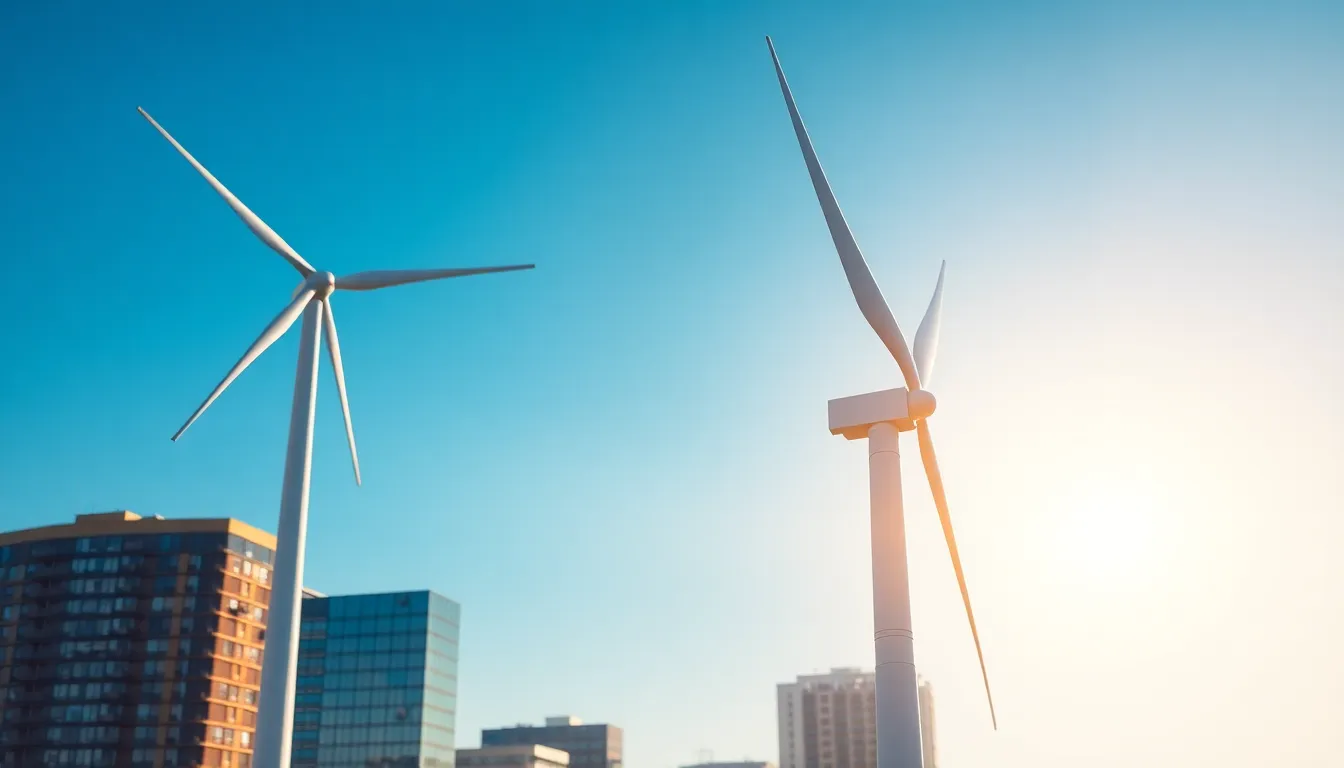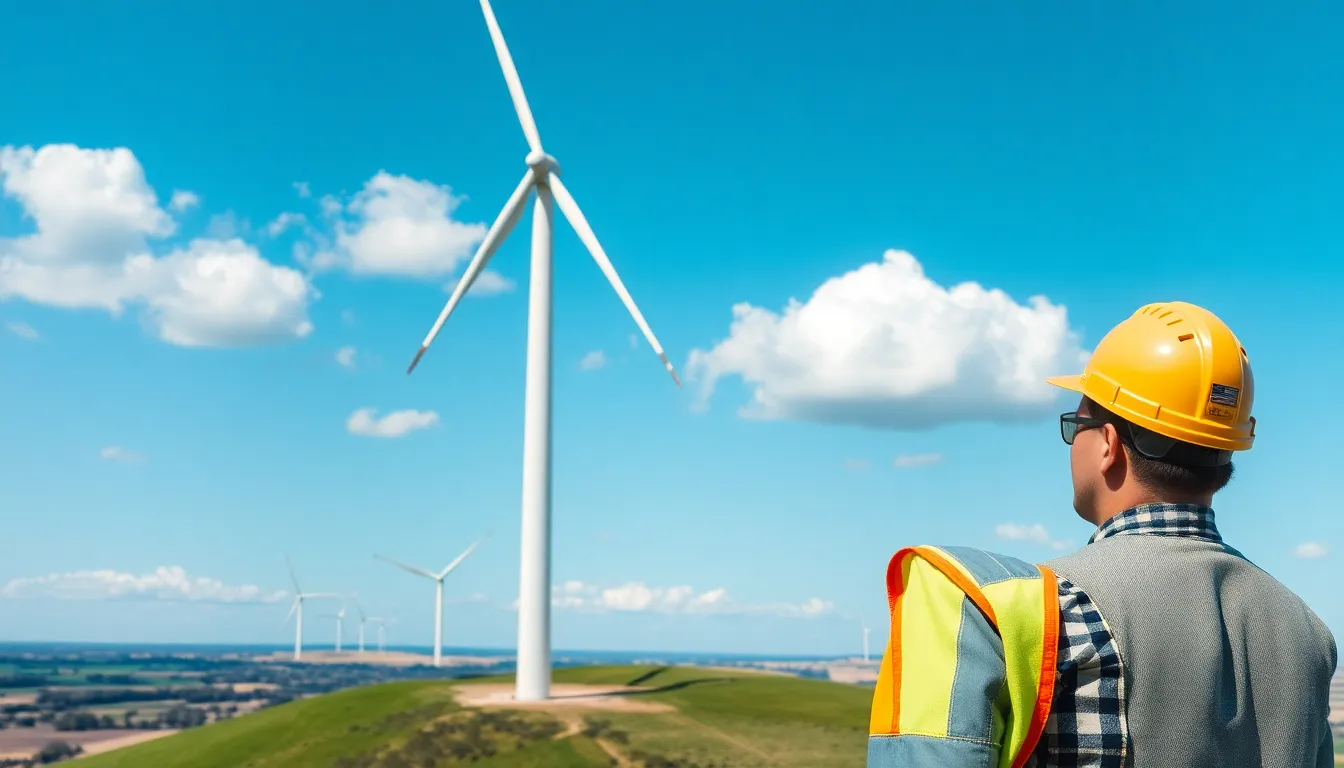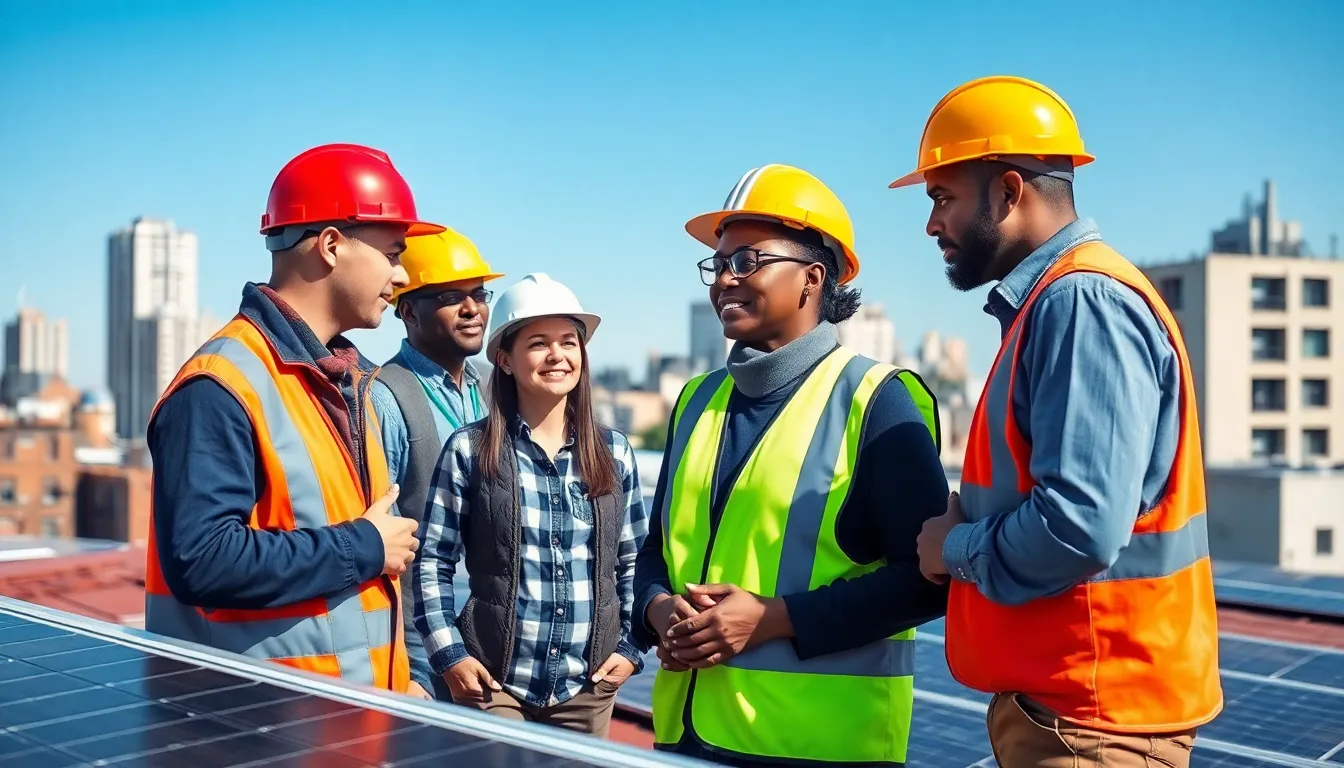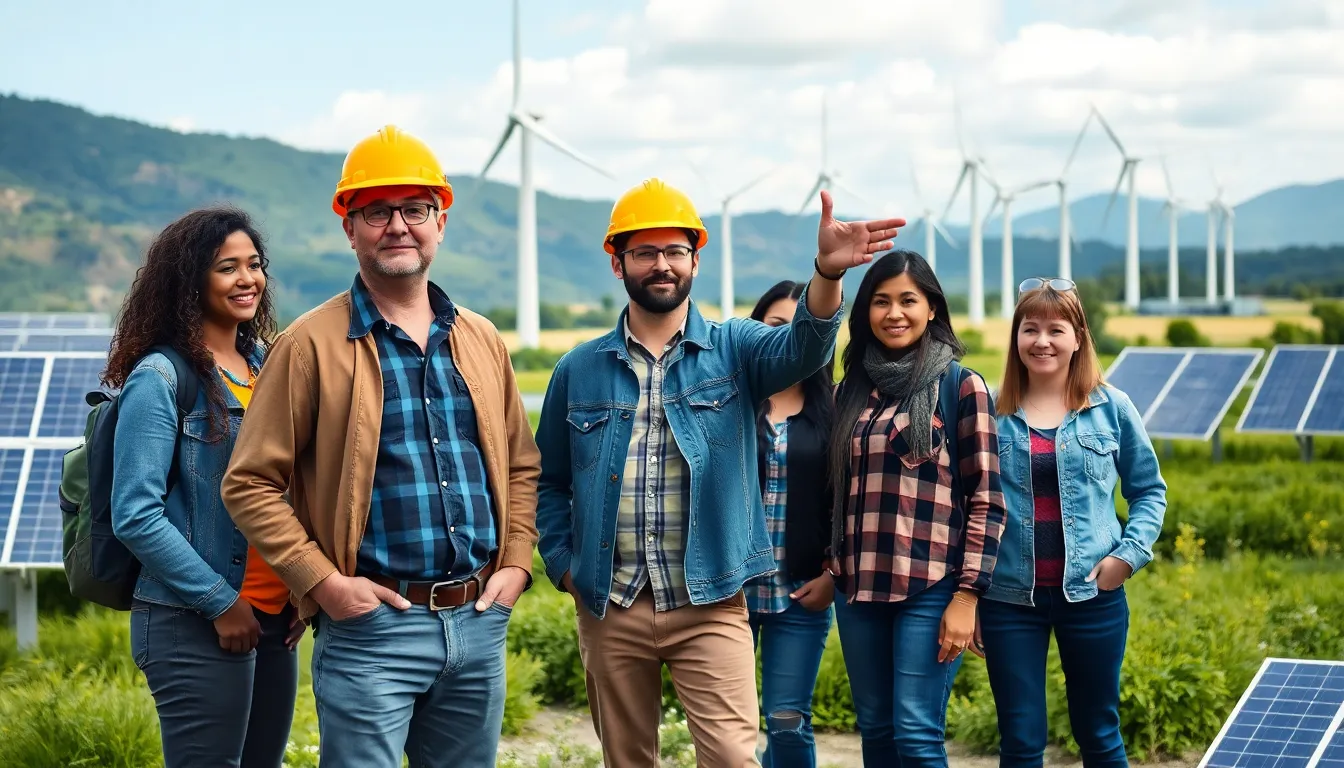Wind turbines are revolutionizing the way the world harnesses energy. As a clean and sustainable source of power, they convert the kinetic energy of wind into electricity, significantly reducing reliance on fossil fuels. With growing concerns about climate change and environmental degradation, the adoption of wind technology is more crucial than ever.
Around the globe, wind farms are sprouting up in both rural and offshore locations, showcasing the versatility and efficiency of this renewable energy source. As technology advances, wind turbines are becoming larger and more efficient, making them a vital player in the quest for a greener future. Understanding how these impressive structures work and their impact on energy production can shed light on the potential they hold for transforming the energy landscape.
Table of Contents
ToggleOverview of Wind Turbines
Wind turbines convert kinetic energy from wind into mechanical energy, which transforms into electricity through a generator. These structures typically consist of a tower, rotor blades, and a drivetrain. The height of the tower can range from 80 to 120 meters, allowing access to stronger winds above ground.
Wind turbine types include:
- Horizontal-Axis Turbines: Able to capture wind from a variety of angles, these turbines feature two or three blades faced directly into the wind. Most installed wind farms use horizontal-axis turbines due to their efficiency.
- Vertical-Axis Turbines: These turbines feature blades that rotate around a vertical axis. They can capture wind from any direction and can operate effectively in turbulent conditions.
Key components of wind turbines include:
- Rotor Blades: Capturing wind energy, blades can range from 30 to 60 meters in length, with designs optimizing energy capture.
- Gearbox and Generator: The gearbox increases rotational speed to generate electricity. Generators convert the mechanical energy from the turbine into electrical energy.
Wind energy’s growth is notable, with global installed capacity exceeding 800 gigawatts in 2023. Countries like China, the United States, and Germany lead in wind energy deployment, contributing significantly to their renewable energy strategies.
Wind turbines also face challenges such as intermittency and initial installation costs. However, advancements in turbine technology and energy storage solutions continue to address these issues, enhancing the viability of wind as a primary energy source.
Planning for wind turbine installations typically considers factors like wind resource assessment, environmental impact, and proximity to power grids, ensuring effective energy generation and distribution.
Types of Wind Turbines

Wind turbines mainly classify into two types based on their axis of rotation: horizontal-axis and vertical-axis turbines. Each type has distinct characteristics that influence their efficiency and suitability for various applications.
Horizontal Axis Wind Turbines
Horizontal-axis wind turbines (HAWT) feature blades mounted on a horizontal rotor, positioned atop a tall tower. HAWTs are widely recognized for their efficiency in converting wind energy into electricity. Key aspects include:
- Design: These turbines typically have two to three blades, designed to capture wind energy effectively.
- Efficiency: HAWTs demonstrate higher energy conversion rates, especially in steady wind conditions, making them ideal for large wind farms.
- Height: Tall towers enhance wind capture, enabling performance at higher altitudes where wind speed is greater.
- Applications: HAWTs dominate the market and are favored in utility-scale wind farms due to their robust output.
Vertical Axis Wind Turbines
Vertical-axis wind turbines (VAWT) have blades that rotate around a vertical axis. This design offers unique benefits suitable for certain environments. Key facets include:
- Design: VAWTs can have various shapes, including the Darrieus and Savonius models, each optimized for different wind conditions.
- Performance: VAWTs excel in turbulent wind environments, where their design allows for consistent energy generation regardless of wind direction.
- Maintenance: Ground-level components simplify maintenance compared to HAWTs, where parts may be hard to access at height.
- Applications: VAWTs find use in urban settings and on smaller scales due to their lower noise levels and multidirectional wind capturing ability.
Understanding these wind turbine types helps in optimizing locations for installations and leverages their characteristics for maximum energy production.
Advantages of Wind Turbines
Wind turbines offer numerous advantages, making them a critical component of modern energy solutions. Their design and functionality lead to significant benefits in renewable energy generation.
Renewable Energy Source
Wind turbines harness wind energy, a renewable source that’s inexhaustible. As long as the sun shines and the wind blows, they can produce electricity without depleting natural resources. Wind energy contributes to reducing greenhouse gas emissions, promoting a cleaner planet. In 2023, wind energy accounted for approximately 10% of global electricity generation, showcasing its growing role in energy portfolios worldwide.
Low Operating Costs
Wind turbines generally incur low operating costs once installed. Maintenance expenses are modest compared to conventional power plants, and they primarily stem from routine inspections and repairs of mechanical components. After the initial investment, the cost per megawatt-hour for wind energy remains competitive, averaging around $30 to $60. This efficiency, combined with zero fuel costs, strengthens the economic viability of wind energy as a primary source of electricity generation.
Challenges of Wind Turbines
Wind turbines face several significant challenges that impact their effectiveness and broader acceptance. Addressing these challenges is crucial for optimizing their deployment and ensuring sustainable energy solutions.
Environmental Concerns
Environmental concerns related to wind turbines include wildlife impacts, noise pollution, and land use. Wind turbines can pose threats to birds and bats, leading to fatalities when they collide with turbine blades. Specific studies indicate that over 600,000 birds die annually from these collisions in the United States alone. Additionally, the noise generated by turbine operation can affect nearby communities, creating opposition to new installations. Moreover, the land required for wind farms may alter natural habitats and ecosystems, necessitating thorough environmental impact assessments before development.
Efficiency and Reliability
Efficiency and reliability present ongoing challenges for wind turbines. Wind energy production is inherently intermittent, dependent on wind availability. Turbines might not generate power during calm weather, resulting in reliance on backup energy sources. Studies suggest that energy generation can fluctuate significantly, with capacities dropping below 10% during lulls. Furthermore, turbine reliability concerns arise from mechanical wear and tear, necessitating regular maintenance to ensure optimal performance. Technological advancements in predictive maintenance and energy storage solutions aim to improve these efficiency and reliability issues, making wind energy a more consistent power source.
Future of Wind Turbines
The future of wind turbines presents significant optimism driven by ongoing technological innovations and changing policy landscapes.
Technological Advancements
Technological advancements are enhancing wind turbine efficiency and performance. Innovations include larger rotor blades, which increase energy capture, and improved materials that reduce wear and tear. Enhanced turbine designs, such as floating wind farms, expand installation possibilities into deeper waters, enlarging access to stronger and more consistent winds. Advanced data analytics enable predictive maintenance, minimizing downtime and optimizing operational efficiency. Additionally, integration with energy storage systems allows for smoother energy delivery, addressing intermittency challenges commonly associated with wind energy.
Policy and Investment Trends
Policy initiatives and investment trends are pivotal for the growth of wind energy. Governments worldwide are implementing renewable energy targets, incentivizing investment in wind technology. Financial support, such as tax credits and subsidies, fosters private investment, driving the deployment of wind farms. Countries like the U.S., China, and Germany are leading in wind energy policies, promoting infrastructure development and facilitating research on innovative turbine technology. Furthermore, global investments in wind energy reached over $100 billion in 2022, indicating robust market confidence and potential for sustained growth in the sector.
Wind turbines represent a pivotal shift in the global energy landscape. As they harness the power of wind, they play a crucial role in reducing greenhouse gas emissions and promoting sustainable energy solutions. The advancements in turbine technology and the increasing investment in wind energy signal a promising future for this renewable resource.
While challenges like environmental impacts and intermittency remain, ongoing innovations are addressing these concerns. The commitment to improving efficiency and reliability continues to drive the industry forward. As countries work to meet energy demands and combat climate change, wind turbines will undoubtedly be at the forefront of the transition to cleaner energy.







